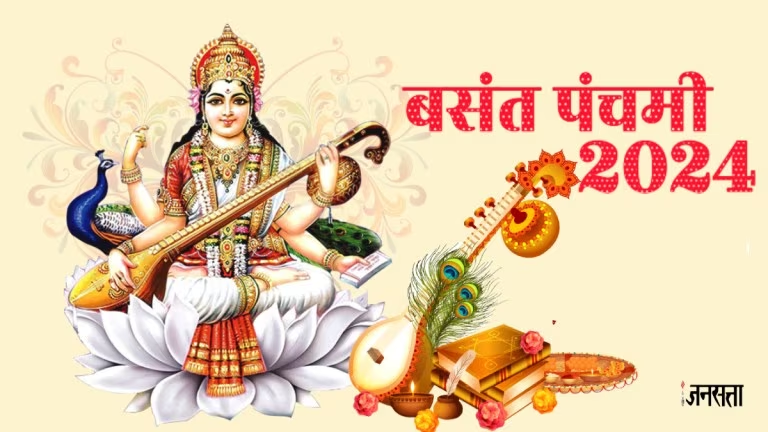Basant Panchmi, a festival that ushers in the vibrant colors of spring, is a cultural extravaganza celebrated with zeal across India. This joyous occasion marks the arrival of the season of renewal, symbolized by blossoming flowers and the fluttering of yellow mustard fields. In this article, we’ll delve into the essence of Basant Panchmi, exploring its traditions, significance, and the lively festivities that accompany it.
Unraveling Basant Panchmi: A Tapestry of Colors and Traditions
Dive into the beauty of Basant Panchmi, a festival that paints the canvas of spring with vibrant hues. Explore traditions, significance, and the joyous celebrations that make this occasion special.
Table of Contents
1. Introduction:

Basant Panchmi, also known as Vasant Panchami, is a celebration that embraces the changing seasons. As winter bids adieu, the air becomes fragrant with the promise of spring. Families come together, streets adorned with yellow, to celebrate the vivacity of life.
2. Origins and Mythology:
Delving into the roots of Basant Panchmi, we uncover ancient tales and myths that narrate the significance of this day. From the worship of Goddess Saraswati to the legends of Kamadeva, the stories add a mystical layer to the festivities.
3. The Symbolic Yellow:

Why yellow, you ask? The color is not just a visual delight but holds cultural importance. Yellow symbolizes prosperity, knowledge, and the blossoming mustard fields that mark the arrival of spring.
4. Saraswati Puja: A Reverence for Knowledge:
Basant Panchmi is synonymous with Saraswati Puja, a day dedicated to the Goddess of wisdom and learning. Schools, colleges, and homes witness the setting up of Saraswati idols, fostering a spirit of knowledge and education.
5. Kite Flying Extravaganza:

Imagine a sky filled with colorful kites dancing to the tunes of the wind. Kite flying during Basant Panchmi is more than a sport; it’s a spectacle that brings communities together in friendly competition.
6. Mouthwatering Delights:
No festival is complete without a feast. Basant Panchmi is no exception, offering a spread of delectable treats. From saffron-infused sweets to traditional dishes, every bite is a celebration of flavors.
7. Regional Variations:
Across India, Basant Panchmi manifests in various forms. From the grandeur of Punjab’s celebrations to the simplicity of South India, each region adds its unique touch to the festivities.
8. Traditional Attire: A Splash of Elegance:

As the festival radiates with colors, so do the vibrant attires worn during Basant Panchmi. Shades of yellow dominate the clothing, symbolizing the jubilant spirit of the occasion.
9. Music and Dance: Echoes of Celebration:
The beats of dhol and the rhythm of folk dances fill the air during Basant Panchmi. Communities come alive with music, celebrating the arrival of spring with infectious enthusiasm.
10. Eco-Friendly Celebrations:
In the wake of environmental awareness, Basant Panchmi witnesses a shift towards eco-friendly celebrations. From biodegradable kites to sustainable decorations, the festival embraces a greener approach.
11. Basant Panchmi and Education:
The festival’s association with knowledge goes beyond Saraswati Puja. Many educational institutions use this day to encourage learning and innovation, fostering a culture of intellectual growth.
12. Community Bonding:
Basant Panchmi brings communities together, fostering a sense of unity and togetherness. The shared joy, laughter, and festivities strengthen the bonds that tie individuals in a community.
13. Why Celebrate?

We celebrate Basant Panchmi for several reasons, encompassing cultural, religious, and seasonal significance. Here’s why this festival is joyously celebrated:
- Welcome of Spring:
- Basant Panchmi marks the onset of spring, bidding farewell to the cold winter months. The festival is a celebration of the rejuvenation of nature, with flowers blooming and the environment coming to life.
- Cultural Tradition:
- It holds cultural importance as communities come together to celebrate the changing seasons. The festival is a way to embrace the beauty of nature and express joy through various cultural activities.
- Goddess Saraswati Worship:
- Basant Panchmi is closely associated with the worship of Goddess Saraswati, the embodiment of knowledge, wisdom, and the arts. Devotees seek her blessings to attain success and excellence in education and creative pursuits.
- Symbolic Yellow Color:
- The predominant use of the color yellow during Basant Panchmi symbolizes the vibrancy of life and the flourishing mustard fields that characterize the arrival of spring. It signifies prosperity, warmth, and positivity.
- Kite Flying Tradition:
- The tradition of flying kites during Basant Panchmi is symbolic of the freeing of the spirit. It represents the breaking free from the constraints of winter and embracing the freedom and joy associated with the spring season.
- Festive Atmosphere:
- Basant Panchmi creates a festive atmosphere with vibrant decorations, cultural performances, and traditional rituals. It brings communities and families together, fostering a sense of unity and celebration.
- Educational Significance:
- The association of Basant Panchmi with Goddess Saraswati emphasizes the importance of education and knowledge. Many educational institutions conduct special ceremonies and events to encourage learning and intellectual pursuits.
- Culinary Delights:
- Like many festivals, Basant Panchmi involves the joy of feasting. Families come together to share delicious meals, and the festival is often marked by the preparation and consumption of special sweets and dishes.
- Cultural Expression:
- Basant Panchmi provides a platform for cultural expression through music, dance, and other artistic performances. It is a time for communities to showcase their heritage and celebrate the richness of their traditions.
In essence, Basant Panchmi is celebrated as a harmonious blend of cultural expression, religious devotion, and the sheer joy of embracing the vibrant and life-affirming season of spring. The festival encapsulates the spirit of renewal, learning, and community bonding.
14. How To Celebrate?

Celebrating Basant Panchmi involves a mix of cultural, religious, and festive activities. Here’s a guide on how to celebrate this vibrant occasion:
- Worship of Goddess Saraswati:
- Begin the day by offering prayers to Goddess Saraswati, the deity of wisdom, knowledge, and the arts. Set up an idol or image of Saraswati in homes or educational institutions and perform traditional rituals.
- Wear Yellow Attire:
- Embrace the symbolic color of Basant Panchmi by wearing yellow attire. This color represents prosperity and the vibrancy of spring. Families often coordinate their clothing to create a festive atmosphere.
- Yellow Decorations:
- Decorate your home with yellow flowers, banners, and other yellow-themed decorations. Create a cheerful and welcoming ambiance to reflect the spirit of the festival.
- Kite Flying Extravaganza:
- Join in the tradition of kite flying, a highlight of Basant Panchmi. Head to open spaces with colorful kites and enjoy the excitement of flying them high in the sky. Organize friendly competitions with family and friends.
- Saraswati Puja:
- If possible, participate in or organize a Saraswati Puja ceremony. Place books, instruments, and tools associated with learning near the Goddess’s idol, seeking her blessings for academic success and creativity.
- Feast on Special Delicacies:
- Indulge in a festive feast featuring traditional Basant Panchmi delicacies. Saffron-infused sweets, snacks, and other regional specialties add a culinary delight to the celebrations.
- Cultural Performances:
- Attend or organize cultural events such as music and dance performances. Traditional folk dances, classical music, and other artistic expressions can add to the festive spirit.
- Educational Activities:
- Acknowledge the educational significance of Basant Panchmi by promoting learning activities. Encourage reading, writing, and artistic pursuits. Educational institutions often organize special events to foster a love for knowledge.
- Community Bonding:
- Share the joy of Basant Panchmi with neighbors and community members. Organize community events, potlucks, or cultural programs to strengthen the bonds within the neighborhood.
- Environmental Awareness:
- Embrace eco-friendly celebrations by using biodegradable kites and minimizing environmental impact. Promote awareness about the importance of preserving nature during the festival.
- Cultural Attire and Accessories:
- Explore the cultural diversity of Basant Panchmi by wearing traditional attire from different regions. Adorn yourself with accessories that reflect the festive spirit.
- Share Knowledge:
- Take the opportunity to share knowledge and stories related to Basant Panchmi with friends and family. Discuss the cultural significance and historical aspects of the festival.
15. Story Behind Basant Panchmi

The story behind Basant Panchmi is steeped in mythology and cultural significance, primarily associated with the worship of Goddess Saraswati. One of the popular narratives linked to Basant Panchmi involves the union of Goddess Saraswati and Lord Brahma, the creator in Hindu mythology.
According to the myth, Lord Brahma was creating the universe, and in the process, he felt the need for a partner to help him in this cosmic task. From his thoughts emerged the radiant and divine Goddess Saraswati. She personified wisdom, knowledge, music, and arts, making her an embodiment of creativity and intellect.
As the story goes, Lord Brahma was captivated by Saraswati’s beauty and wisdom. He expressed his admiration and proposed marriage to her. Saraswati agreed, but on one condition – that Brahma must accept her as his equal and not prioritize her physical appearance over her knowledge and wisdom.
This condition posed a challenge for Lord Brahma, as he struggled to find a way to treat Saraswati as an equal. While contemplating, a divine voice guided him to recognize Saraswati’s true essence, and Brahma, in a moment of realization, accepted her as his equal partner.
The celestial wedding of Lord Brahma and Goddess Saraswati is believed to have taken place on the day of Basant Panchmi, symbolizing the union of creativity and intellect. This union is considered auspicious, and Basant Panchmi is celebrated as the day when Goddess Saraswati blesses devotees with wisdom, knowledge, and the ability to excel in the arts and sciences.
In addition to this mythological tale, Basant Panchmi is also associated with the legend of Kamadeva, the Hindu god of love. According to this narrative, Kamadeva aimed his love arrows at Lord Shiva to awaken him from deep meditation. However, Shiva, disturbed by the intrusion, opened his third eye, and Kamadeva was consumed by the fire emitted from it. It is believed that Kamadeva was reborn on Basant Panchmi, signifying the reawakening of love and vitality in nature.
The combined influence of these stories has woven a rich tapestry of cultural and religious significance around Basant Panchmi, making it a celebration that honors knowledge, creativity, and the arrival of the colorful and vibrant spring season.
Conclusion
As we wrap ourselves in the vibrant hues of Basant Panchmi, let’s cherish the traditions that make this festival special. From the worship of wisdom to the thrill of kite flying, every aspect adds a unique stroke to the canvas of celebration.
Frequently Asked Questions:
1. What is the significance of the color yellow in Basant Panchmi?
The color yellow in Basant Panchmi symbolizes prosperity, knowledge, and the arrival of spring. It is a visual representation of the vibrancy associated with the festival.
2. Why is Saraswati Puja an integral part of Basant Panchmi celebrations?
Saraswati Puja is dedicated to the Goddess of wisdom and learning. It is believed that seeking her blessings on Basant Panchmi ensures success in education and knowledge pursuits.
3. How did the tradition of kite flying become associated with Basant Panchmi?
Kite flying during Basant Panchmi has historical roots and is linked to the idea of celebrating the changing seasons. It has evolved into a vibrant and competitive tradition.
4. Are there regional variations in the way Basant Panchmi is celebrated?
Yes, across India, Basant Panchmi takes on various forms, with each region contributing its unique touch to the festivities. From Punjab to South India, regional variations are diverse.
5. How has Basant Panchmi adapted to environmental concerns?
In recent years, there has been a growing emphasis on eco-friendly celebrations during Basant Panchmi. This includes the use of biodegradable kites and sustainable decorations to reduce environmental impact.
Search us on Google by typing Interestopedia.com
